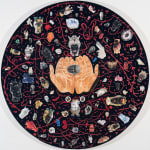WILLIAM VILLALONGO
Black Menagerie (Testa di Moro), 2023
Acrylic, velvet flocking and paper collage on wood panel
47 3/4 in. dia. x 2 3/4 in.
Copyright The Artist
Photo: Chrysler Museum of Art, Museum purchase 2024.8
Further images
Here in 'Black Menagerie (Testa di Moro),' Villalongo presents a constellation of Testa di Moros. Interested in fact and fiction, Villalongo employs mythological histories, using the Testa di Moro to...
Here in "Black Menagerie (Testa di Moro)," Villalongo presents a constellation of Testa di Moros. Interested in fact and fiction, Villalongo employs mythological histories, using the Testa di Moro to reconsider narratives and depictions of the Black past.
In Sicilian mythology, the Testa di Moro represents a tale of love and betrayal. The legend, dating to the 11th century, takes place in Sicily during a period of Moorish domination. The tale follows a budding romance between a Sicilian maiden and a young Moorish prince. The two carry on their love affair until the maiden discovers the prince has deceived her — he would soon leave Sicily to return to his wife and children. In a passionate rage, she goes to his bedside in the middle of the night and brutally beheads the Moor. As a testament to her heartbreak, the young girl keeps the head of her lover so that he might stay with her forever. Placing the head on her balcony, she fills it with basil where, watered by her tears, the herb grows so bountiful and fragrant that all of Sicily wanted their own Testa di Moro.
In Sicilian mythology, the Testa di Moro represents a tale of love and betrayal. The legend, dating to the 11th century, takes place in Sicily during a period of Moorish domination. The tale follows a budding romance between a Sicilian maiden and a young Moorish prince. The two carry on their love affair until the maiden discovers the prince has deceived her — he would soon leave Sicily to return to his wife and children. In a passionate rage, she goes to his bedside in the middle of the night and brutally beheads the Moor. As a testament to her heartbreak, the young girl keeps the head of her lover so that he might stay with her forever. Placing the head on her balcony, she fills it with basil where, watered by her tears, the herb grows so bountiful and fragrant that all of Sicily wanted their own Testa di Moro.





